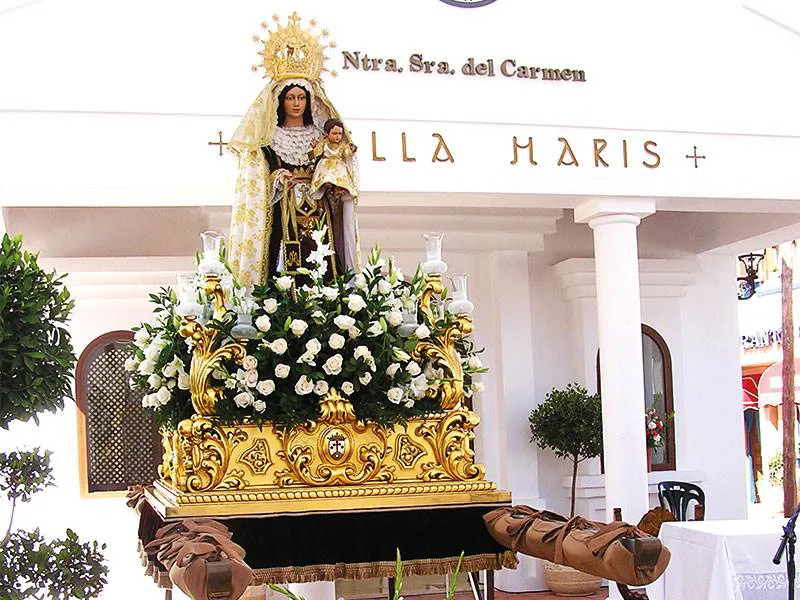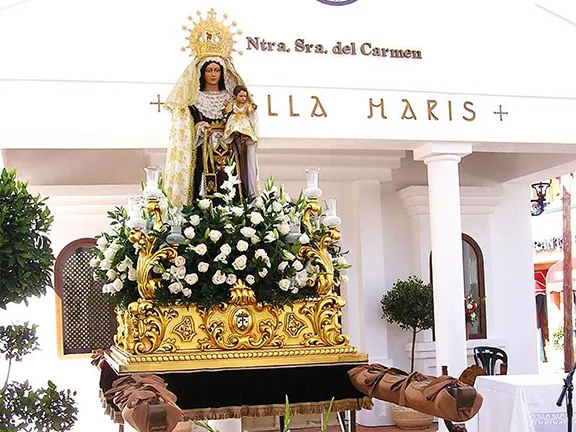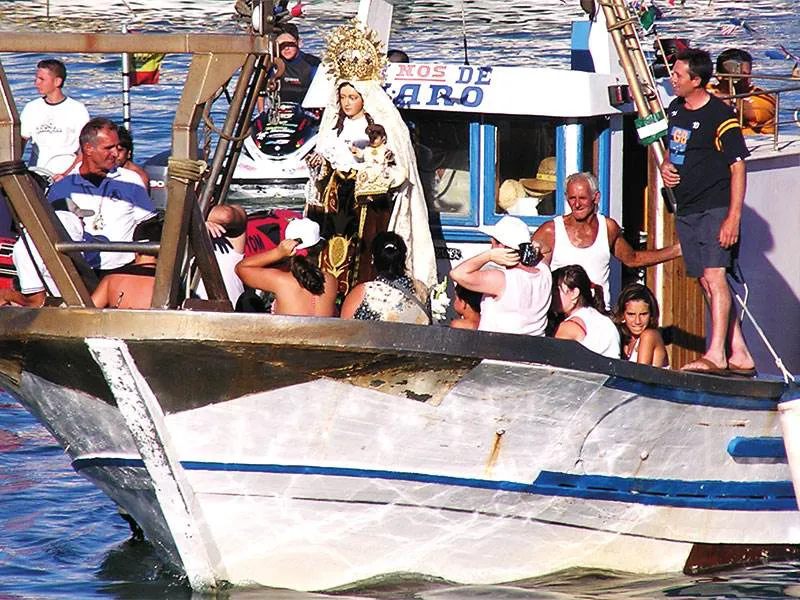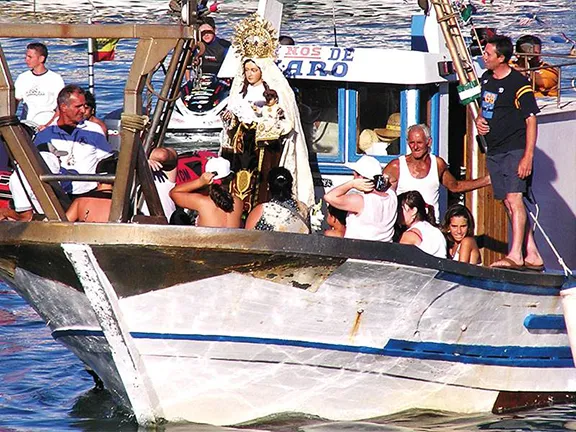Immerse yourself in the colourful festivities of the Virgen del Carmen festival in Andalucía, as fishermen and sailors honour their patron saint with maritime processions, street parties, and cultural performances. Discover the enchanting blend of faith, folklore, and the mesmerizing beauty of the Mediterranean Sea in this captivating celebration.
By Nick Nutter | Updated 2 Aug 2023 | Andalucia | Events |
Login to add to YOUR Favourites or Read Later


Virgen del Carmen - Castillo
Every year, the region of Andalucía in southern Spain comes alive with vibrant celebrations honouring the Virgen del Carmen. This religious and cultural festival, deeply rooted in the maritime traditions of coastal communities, pays homage to the patron saint of fishermen and sailors. In the picturesque fishing villages of Andalucía, the Virgen del Carmen festival is a colourful spectacle, blending faith, folklore, and the mesmerizing beauty of the Mediterranean Sea.
The festival takes place on the 16th of July, when locals gather to honour and celebrate the Virgen del Carmen, known as the "Queen of the Seas." The festivities usually begin with a traditional maritime procession, as a beautifully adorned statue of the Virgen del Carmen is carried through the streets towards the sea. The statue is placed on an elaborately decorated boat or a fishing vessel, accompanied by a flotilla of small boats, yachts, and even kayaks, adorned with flowers and colourful bunting.


Taken to sea - Duquesa
The procession moves gracefully across the water, guided by skilled sailors and accompanied by the rhythmic beat of drums and lively traditional music. As the boats sail along the coast, local residents line the shores, waving flags and showering petals onto the water, demonstrating their devotion and asking for the Virgen del Carmen's protection for the fishermen and seafarers.
The enchanting sight of the procession is only part of the magic of the Virgen del Carmen festival. In the evening, the festivities continue with vibrant street parties, parades, and live performances featuring flamenco music and dance. The air fills with the aroma of traditional Andalusian cuisine, as streets are lined with stalls offering delectable seafood dishes, tapas, and sweet treats.
The festival exudes a sense of unity and community, bringing people together to celebrate their shared heritage and pay tribute to the sea, which has sustained their livelihoods for generations. It is a time when fishermen and sailors, young and old, gather to honour their patron saint and offer prayers for safe voyages and abundant catches.
Beyond the religious significance, the Virgen del Carmen festival also symbolizes the connection between Andalucía's people and the sea, highlighting the region's rich maritime traditions. It serves as a reminder of the importance of preserving and respecting the oceans and the environment.
If you have the opportunity to experience the Virgen del Carmen festival in Andalucía, prepare to be immersed in a captivating blend of faith, culture, and maritime heritage. The sights, sounds, and flavours of this extraordinary celebration will leave an indelible mark on your heart, offering a glimpse into the soul of Andalucía and its profound relationship with the sea.
‘The Spanish know how to do festivals. We nod to religion, then we party,’ according to a renowned teacher in Asturias. The festival of Virgen del Carmen perfectly exemplifies this maxim.
It all started with the prophet Elias, about 300 BC. The story goes that, in the vicinity of Mount Carmelo (the Hebrew word for garden), now Mount Carmel south of Haifa in Israel, there was a drought that had lasted many years. The holy men retreated to the mountain to pray for rain. Elias saw a cloud rise from the sea and drift over the land, bringing the long sought-after rain.
Elias, always one to elaborate a story, interpreted the event as foretelling the coming of a virgin who would conceive a saviour who would bring a rain of blessings on humanity. Hermits on Mount Carmelo started to worship the virgin and were, according to the scriptures, vindicated 300 years later. The hermits eventually, by the 11th century AD, became known as Order of the Brothers of the Blessed Virgin Mary of Mount Carmel and then simply Carmelites.
We now leap forward to the 13th century AD. An Englishman, Simon Stock, was trotting around Europe founding monasteries dedicated to the cult of the Virgen del Carmen, the Carmelites. On the 16th July 1251, the Virgin appeared to him holding a religious artefact, a scapular, which is a sort of apron. She told him, ‘Let this be a sign and privilege for you and all Carmelites. Whoever dies wearing the scapular will never suffer eternal fire.’ Simon didn’t know what to make of the pronouncements of this woman waving a pinny, so he decided that henceforth the 16th July should be a religious holiday.
Within a century or so the Virgen del Carmen had become known as ‘Estrella del Mar’, the star of the sea, of particular importance to Catholic mariners who prayed for her protection and considered her their patron saint. In the 18th century, the Carmelites were widespread throughout Spain and the Spanish Admiral, Antonio Barcelo Pont de la Terra, officially changed the patronship of Spanish sailors from Saint Telmo to that of the Virgen del Carmen.
By the end of the 18th century, the celebrations on the 16th July were well established on the Mediterranean coasts of Spain.
While the 16th is a day celebrated in every coastal town, the holiday is extended in some places. Nerja traditionally has a three-day holiday with a huge ‘moraga’, an outdoor party with food and drink, on one of the evenings. Sardines are roasted on spits on a large open pit on La Torrecilla Beach and given to bystanders. This charitable act has been compared to the feeding of the five thousand but has yet to be accomplished in Nerja using just five loaves and two fishes.
In every coastal town though, July 16th is when the statue of the Virgen is taken from the church and carried through the streets accompanied by bands and crowds of followers. In most places, she is put on a boat for a trip around the bay this time accompanied by a flotilla of small boats all dressed with flags and packed with revellers. Occasionally, if the seas are too rough, she will be carried around town again.
Food, drink and fireworks with music blasting from speakers and in many cases, live bands, make this beach party the liveliest of the year and one at which you will see the sunrise the following morning if you can stand the pace.
The festival is especially important in Málaga city where the procession is repeated the Sunday following the 16th July. In 1981 the diving club placed an image of their patron on the seafloor. Members descend every year to pay homage.
The festival of Virgen del Carmen is well celebrated in San Luis de Sabinillas, Puerto de la Duquesa and Castillo de la Duquesa, Estepona, Fuengirola, Torremolinos, Málaga, Rincón de la Victoria, Velez Málaga, Nerja, Almunecar, Roquetas de Mar and Almeria and at many of the smaller fishing towns on the coast.
Read more about these coastal towns:
Travelling to/around Spain and need some help? Here are our favourite travel resources.
We usually use Booking.com to look for hotels or apartment rentals. Lots of choice & you can unlock more discounts with their Genius loyalty programme!
To research transportation options around Spain, we like using Omio. It’s an easy way to compare different modes of transport and prices in one place.
For last-minute holiday deals, check out Expedia UK.
Looking for things to do? Viator has a huge catalog of activities and tours across many cities in Spain. We also love Get Your Guide!
Guruwalk is our favourite platform to find the best free walking tours in a city.
For money transfers or spending overseas in foreign currency, Wise is our favorite borderless banking service.
Travel insurance is a must to protect against emergencies and unexpected incidents. Get a no-obligation quote from SafetyWing here.